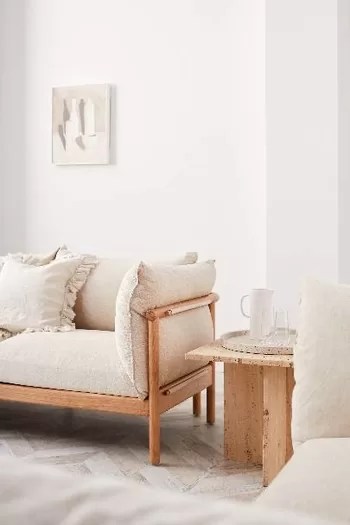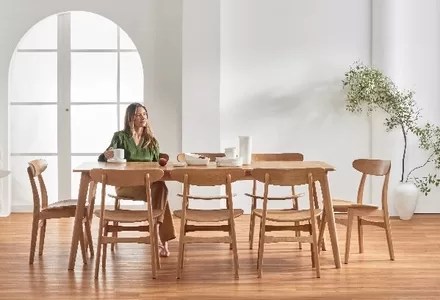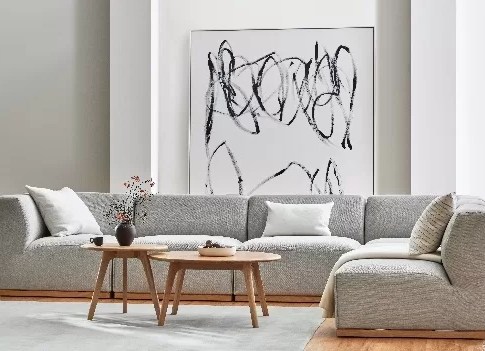Top 12 Ways Consumers Can Support the Anti-Fast Furniture Movement by Shopping Sustainably
Fast-furniture, like fast fashion, is creating an unsustainable landfill problem in the same way that fast food created health issues. As a growing number of households embrace sustainability, their shopping habits are evolving to reflect a desire for products made with ethical materials and sustainable practices.
According to a recent Sustainability Report from Power Retail, over half of Australian shoppers are now willing to pay more for sustainably produced goods. This shift is reshaping the way people furnish their homes, moving away from fast furniture toward quality, timeless pieces built to last.
The rise of fast furniture, characterized by mass-produced, affordable items with short lifespans, is contributing to landfill waste, deforestation, and a throwaway culture. As consumers grow more conscious of sustainability, the anti-fast furniture movement is gaining momentum.
One standout advocate for sustainable furniture is IconByDesign, a family-owned business that emphasizes direct collaboration with master craftsmen to create heirloom-worthy furniture. Their focus is on quality, not quantity, encouraging consumers to reject disposable goods and embrace meaningful, long-term investments.
Advertisement
Here are twelve ways to support this movement and make mindful choices that benefit both the planet and your home. Nikita Crockett, IconByDesign’s Design Service Lead, offers her five expert tips for shopping sustainably, helping consumers transform their homes while reducing environmental impact.
1. Invest in Interchangeable, High-Quality Designs

When it comes to sustainable shopping, the key is to think long-term. “Choosing well-crafted pieces ensures they stay with you for decades,” Crockett explains.
“Stick with timeless core furniture, such as a bed, coffee table, or sofa, and incorporate seasonal trends with accessories like rugs or throw pillows.” This approach makes it easier to adapt to changing styles without replacing major items.
Trend-based furniture often becomes outdated quickly. Instead, select classic or multifunctional designs that can adapt to changing decor styles and needs.
A timeless piece, such as a mid-century modern sofa, holds value and appeals for years, making replacements unnecessary. We recently sold a Parker teak dining room table and six chairs from the 1960s for nearly $3,000 so we literally got 50 years of use for free.
Nikita’s Picks:
- Olivia 2-Seater Fabric Sofa ($2,309): Easily refresh the look by changing its fabric color for each season.
- Tegel Hand-Knotted Wool Rug ($1,749): Swap out rugs to embrace seasonal color trends without replacing your core decor.
2. Choose Quality Over Quantity
Investing in high-quality furniture pieces ensures durability and longevity. Well-crafted items may cost more initially, but they outlast cheap, mass-produced alternatives. Look for solid wood, metal joinery, and upholstery with strong stitching that withstand wear and tear.
3. Opt for Sustainable and Authentic Materials

Prioritizing solid wood and quality fabrics ensures your furniture will not only last but also have a lower environmental impact.
Crockett advises looking for materials like American Oak, American Walnut, and New Zealand wool.
“These materials are more durable and sustainable,” she notes, “reducing the need for frequent replacements and helping lower your carbon footprint.”
Nikita’s Picks:
- Bruno Chest ($3,299): Crafted from solid American Walnut, this piece is designed to endure and elevate your bedroom decor.
- Greta Handwoven Wool Rug ($749): Made from pure New Zealand wool, adding a touch of luxury and sustainability to your space.
4. Embrace Pre-Owned and Vintage Furniture
Buying vintage or pre-owned furniture is an easy way to reduce waste and participate in the circular economy. Crockett encourages shoppers to explore vintage markets for unique finds.
“These pieces often have a charm that mass-produced items can’t match,” she says, “and they can be blended seamlessly with modern furniture to create an eclectic, sustainable home.”
Supporting the circular economy by purchasing pre-owned or vintage furniture is a great way to reduce environmental impact. Flea markets, estate sales, and online marketplaces offer unique finds with history and character.
Restoring old furniture can also be a rewarding, eco-friendly project. Rather than discarding old furniture, upcycling gives it new life through creativity. A coat of eco-friendly paint or reupholstering with natural fabrics can transform worn items into statement pieces. DIY projects are a fun way to customize furniture while reducing waste.
Shopping vintage also provides a cost-effective way to experiment with styles, making it easier to avoid falling into the trap of fast furniture trends.
5. Paint Old Furniture for a Fresh Look
Transform outdated furniture with a fresh coat of paint instead of replacing it. Chalk paint is a great option—it requires little to no prep work and gives a beautiful matte finish. You can also embrace the distressed look by lightly sanding the edges for a vintage, shabby-chic effect. This approach not only saves money but also keeps perfectly good pieces out of landfills.
6. Look for Flexibility in Design
As your lifestyle and needs evolve, adaptable furniture helps prevent waste. Modular designs and removable, washable covers offer versatility, allowing consumers to update their space without buying entirely new furniture.

“Investing in modular sofas lets you add or rearrange sections over time, creating a piece that grows with you,” Crockett recommends.
Nikita’s Picks:
- Anika Modular 3-Seater Sofa ($4,374): A versatile piece with interchangeable sections to suit different layouts and styles.
- Walter Modular Sofa (starting from $2,699): Mix and match pieces to expand as your space evolves.
7. Avoid Flat-Pack Temptations
While flat-pack furniture is convenient, many pieces are designed to last only a few years. Where possible, avoid these in favor of solid, long-lasting alternatives. If flat-pack is unavoidable, choose companies known for sustainable practices and modular designs that allow repairs.
With many young professionals often transfer between jobs and locations, the transient lifestyle lends itself to the easy-to-transport flat-pack furniture. It only takes 2 or 3 moves and pieces warp, break or are lost. It is false-economy to buy cheap flat-pack furniture. Solid and quality pieces will last years and even a lifetime, if properly handled and cared for.
8. Support Brands with Transparent Supply Chains
Understanding how and where furniture is made is critical for sustainable shopping. IconByDesign emphasizes transparency by working closely with select factories and sourcing agents, ensuring their products meet ethical standards throughout the supply chain.
Crockett encourages consumers to research brands and seek those committed to sustainability. “Look for companies that are upfront about their practices and sourcing,” she says. “Championing these brands helps shift the industry toward more responsible production.”
Locally made furniture reduces the carbon footprint associated with long-distance shipping. Artisan furniture is often crafted from sustainable materials and reflects a commitment to craftsmanship. Seek out small, independent businesses to support the livelihoods of local communities. Supporting local artisans keeps your dollar locally and is a great conversation piece with visitors.
Pro Tip: While it may be tempting to replace all your existing furniture with sustainable alternatives, Crockett advises against it. “Throwing away functional items defeats the purpose,” she explains. “Instead, replace pieces gradually, starting with items that need upgrading, and focus on building an eco-conscious collection over time.”
9. Look for Sustainable Certifications
When buying new furniture, check for certifications such as FSC (Forest Stewardship Council) or GREENGUARD to ensure the wood and materials are sustainably sourced. Certifications provide transparency and accountability in a market that can be murky about its environmental claims.
10. Rotate Decor Instead of Replacing Furniture
Use rugs, cushions, and throw blankets to update your space instead of purchasing new furniture. Seasonal accessories allow you to refresh your decor without creating unnecessary waste.
11. Repurpose Furniture for New Uses
Think outside the box and give old furniture new life by repurposing it for different spaces. An old desk can become a workstation in an art studio, a potting bench in a garden shed, or a working display table in a glasshouse. Repurposing is a creative way to extend the usefulness of furniture and reduce the need for new purchases, all while adding character to your home.
12. Rent or Borrow for Temporary Needs
For short-term needs or events, consider renting or borrowing furniture rather than buying. Furniture rental services provide stylish options while minimizing clutter and waste.
A More Thoughtful Future
Sustainable shopping is about more than just avoiding fast furniture—it’s about making intentional decisions that align with your values and reduce waste.

With guidance from experts like Nikita Crockett, consumers can take steps toward furnishing their homes with quality pieces that stand the test of time.
By choosing durable materials, embracing vintage finds, and supporting brands with transparent supply chains, shoppers are helping to build a more sustainable future—one thoughtfully chosen piece at a time.
Through IconByDesign’s commitment to quality and longevity, consumers are encouraged to think beyond trends and invest in furniture that becomes part of their story.
With these actionable tips, you can take the first step toward a more sustainable home—and a better planet.
Support the anti-fast furniture movement by educating yourself about sustainable practices and sharing knowledge with others. Discuss the environmental costs of fast furniture with friends and family, and use social media to promote sustainable brands and solutions. Consumer demand drives change—every voice matters.
The new Australian Sustainability Reporting Standards (ASRS) set for 2025, will establish a new benchmark for environmental impact reporting and management. The ASRS will align with global efforts to enhance transparency and comparability in corporate performance by integrating sustainability into core financial reporting. Retailers are preparing to meet disclosure requirements and mitigate potential regulatory risks to their operations.
Wrapping Up
Supporting the anti-fast furniture movement is about adopting mindful shopping habits that prioritize longevity, craftsmanship, and environmental stewardship. By making intentional choices—whether through buying second-hand, supporting local artisans, or opting for sustainable certifications—consumers can help combat the throwaway culture and contribute to a more sustainable future.
With over a decade of experience spanning fashion, retail, makeup, and interior design, Nikita Crockett brings passion and creativity to every project. Her expertise shines through in areas such as spatial planning, textiles, and digital media. Currently serving as IconByDesign’s Design Service Lead, Nikita also oversees the brand’s content creation and manages its social media presence, shaping the company’s voice and visual identity.
Related Feature Stories
The Clam Chair: An Iconic Design by Phillip Arctander
Directoire Furniture: An Early Glimpse of Modern Design
Louis XV And XVI Furniture: Understanding The Obsession
Cane Wicker & Rattan Furniture
News, Information & Buying Guides on Antique Furniture
Advertisement




